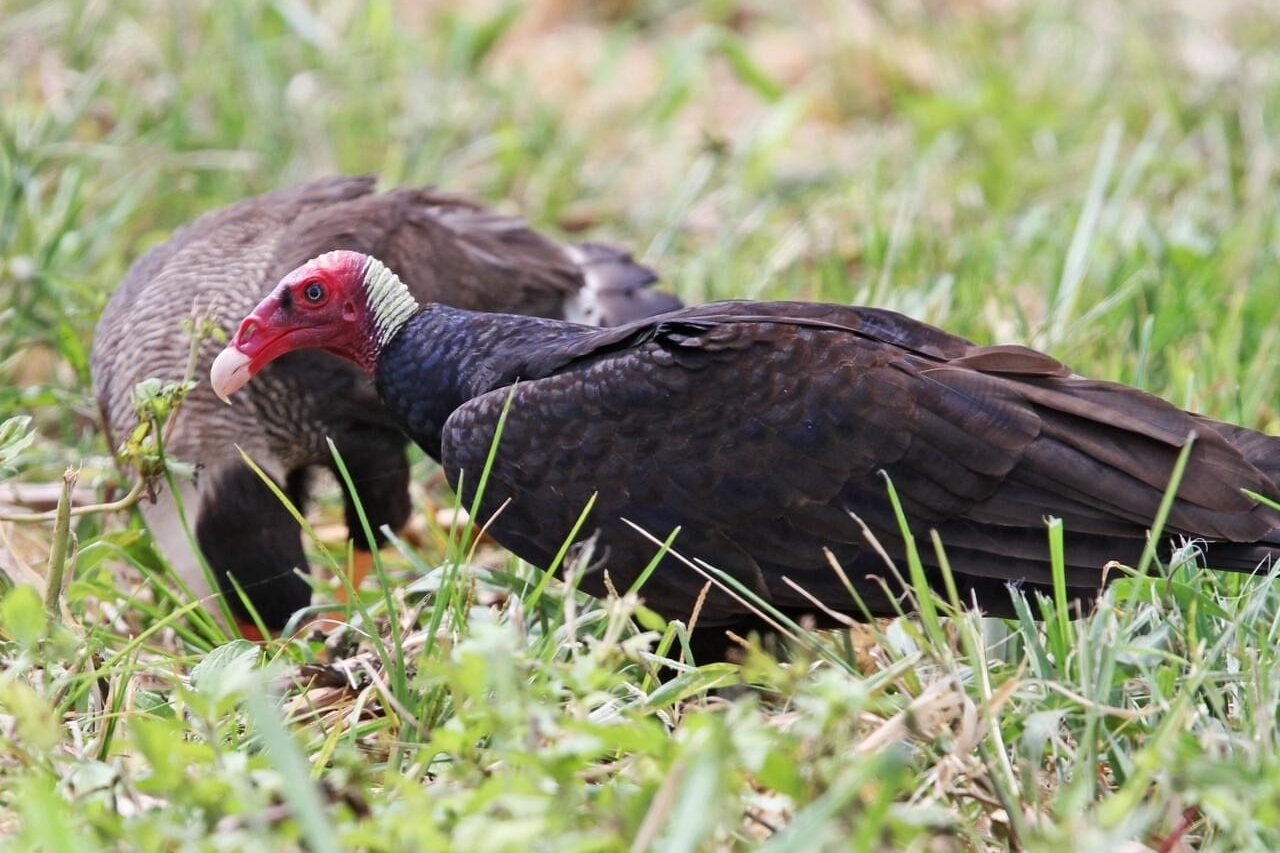Operational Activities: Vultures
Vultures are migratory birds that are protected by the Migratory Bird Treaty Act, which is administered by the U.S. Fish and Wildlife Service. However, vultures are sometimes associated with problems, such as agricultural and property damage and health and safety concerns. Integrated solutions to address problems may include habitat manipulation, dispersal techniques, and population management.
Two different species of vultures, black vultures and turkey vultures, are native to North America. As scavengers, vultures play an important role in the ecosystem. Formerly suppressed by the effects of pesticides on reproduction, populations of both species have increased dramatically in recent years. Vultures adapt and thrive in close proximity to people. They often form large roosts and loafing areas, numbering from a few dozen to hundreds of individual vultures. Population trends probably will continue to increase, as will the frequency of conflicts with people.
Biology and Ecology
Understanding Wildlife, Damage, and Management
Because of their adaptable nature, increasing numbers, and complex behavior, vultures are involved in a wide range of conflicts. These conflicts can occur in agricultural environments as well as suburban and rural settings.
Damage to Agriculture
Both turkey and black vultures eat animals that have died from various causes. Black vultures, however, can also attack and kill calves, lambs, piglets, and other vulnerable animals. This predatory behavior often results in serious injury to livestock, as vultures target the eyes and soft membranous extensive tissues. The livestock often die from the attack or must be euthanized due to the extent of their injuries. In most cases, methods can be employed to reduce livestock depredation. These are covered in the Management Methods section. A first step in addressing depredations is calling Wildlife Services in your state.
Damage to Property and Infrastructure
Problems often occur when large groups of vultures roost or occupy woodlots near people's homes. Property damage to residences and commercial buildings from black and turkey vultures includes tearing window caulking, roof shingles, vent seals, rubber roof liners, and pool covers. They may also damage vehicles by scratching paint, removing rubber seals and wipers and puncturing vinyl seat covers. Black and turkey vultures can affect people's quality of life due to accumulations of feces and regurgitations, especially when they loaf on roofs of houses, office buildings, playground equipment, and communication towers. Vultures roosting on electrical transmission structures can produce accumulations of feces and vomit that in turn lead to power outages and communication disruptions, at great expense to service providers.
Health and Safety Concerns
Vultures can cause health and safety problems due to the accumulations of their droppings and their roosting and soaring behaviors. Contamination of water sources may occur when coliform bacteria from droppings enter water towers or springs which supply water to residences and businesses. Citizens frequently express health concerns because of the accumulation of droppings from roosts near their homes. Many people consider vultures a nuisance because of the white-wash effect their droppings leave on trees at roost sites, and the ammonia odor that emanates from roost sites. Large concentrations of vultures are common, especially near roosts and landfills. Vultures can be hazardous to aircraft, especially when waste management facilities and landfills are located near airports. Vultures are especially prone to bird strikes because they are large, slow-moving, not very maneuverable, and often multiple birds can be seen soaring together.
Vulture management can be complicated and site specific. Biologists can examine a location and suggest management methods starting with habitat features and reducing attractants. Auditory and visual dispersal methods such as lasers and propane cannons, as well as deploying effigies can be effective. Wildlife Services provides technical information and direct management for vulture conflicts and can facilitate the required depredation permit process through WS State Offices. A Migratory Bird Depredation Permit must be obtained from the U.S. Fish and Wildlife Service, and State laws must be consulted and adhered to, prior to initiating actions to remove vultures or handle their nests and eggs.
To contact the Wildlife Services State Office near you for additional information, state-specific assistance, and recommendations related to vultures, please contact your state.
More Information
Wildlife Services' National Wildlife Research Center (NWRC) conducts research and investigational activities on a wide variety of wildlife damage issues. NWRC Scientists at the NWRC Florida Field Station focus much of their efforts on developing methods for management of turkey and black vultures. In the course of this research, hundreds of vultures have been marked with wing tags having individual 3-letter codes. You can help by reporting sightings of tagged vultures.
Research publications relating to specific vulture management issues can be accessed through the link below. NWRC has also developed guidelines for using effigies as a roost dispersal tool to minimize property damage, protect agriculture, and to relieve human health and safety concerns.
More Information
Contact Us
Wildlife Damage Assistance
Find your State office in the dropdown menu or call 866-4USDA-WS to be automatically routed to a State office based on the area code you are calling from.



